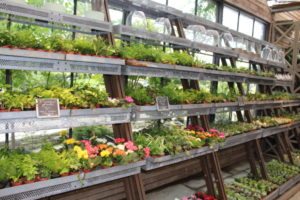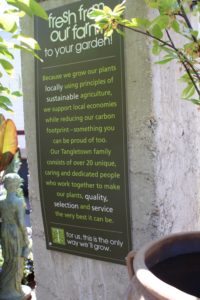Be A Lean, Money-Making Machine
This month I’ve invited a very smart guy to “guest host” the “Dollars and Sense” column. If you were one of the lucky few to hear Andy Rogish speak at last year’s OFA Short Course, you know he’s smart and he puts money in your pockets. Rogish is the quality systems manager at Yoder Brothers, Alva, Fla., and an expert in lean manufacturing. Here’s Rogish’s take on how you can make more dollars using lean common sense.
What is lean? In practical terms, it is looking at and doing your core business in a totally different way. It’s embodied in the Toyota production system. “What a minute!” you say. “Toyota makes cars. What does that have to do with my garden center?” Actually, quite a lot. In your business, you basically take raw or semi-finished materials, process them (either by modifying and maintaining them or grouping them for presentation) and provide an output to your customer just like Toyota!
Learn About Lean
Even though the modern lean process had its beginnings in the early days of the Ford Motor Co., decades before being refined by Toyota, lean has had multiple applications over and above the automotive industry. As you might expect, it’s finding great application in the traditional manufacturing industries and also impacting timber, landscaping, floriculture, healthcare, construction and even dairy.
In the late 1980s, James P. Womack, Ph.D., the founder and chairman of Lean Enterprise Institute (www.lean.org) was one of a group of researchers, including Daniel Roos and Daniel T. Jones, who conducted a 5-year study of the Toyota Motor Corp. and published the results in the book The Machine that Changed the World: The Story of Lean Production. Womack and Jones later wrote Lean Thinking: Banish Waste and Create Wealth in Your Corporation and Lean Solutions. In his books, Womack takes the lean principles used by Toyota and puts them in generic industrial terms, enabling readers to translate those same principles into a unique application for virtually any industry.
What The Customer Sees
Lean sees the world in terms of value and waste. Value is determined from the viewpoint of the final customer. While we all strive to stock our shelves and benches with products the customer wants, lean looks at the final purchase product and the process, thereby building the customer’s voice into both the process and product. In generic terms, value is defined by answering this question: “Does this activity change the form, fit or function of the product and is it something the customer is willing to pay for?” Every activity you or I perform in our business is either value added or a form of waste.
Waste comes in eight flavors:
- Excess inventory
- Unnecessary transportation
- Overprocessing
- Waiting time
- Unnecessary motion
- Producing defects
- Overproduction
- Unutilized employee creativity
Lean thinking provides a set of tools that helps reduce or eliminate waste in order to build value for the customer. It’s not about doing an activity with bare minimum resources; lean is about doing only what the customer wants.
Say you walked into a garden center and were presented with two identical plants in two identical pots. One plant is marked 50 percent higher than the other. Your curiosity is sparked. You ask an employee the reason for the price differential. He replies, “The more expensive plant is from a vendor who installed a new software system.” Would you pay extra for that identical plant? Would the installation of new software be a value-added reason for you to spend extra money? Of course not!
Software and other support functions are absolutely essential to our business, but they don’t add value from the perspective of the customer. If the same employee told you the plant in question costs more because it is 50 percent more drought resistant and can last up to 10 days without water in the summer, you might pay more. There is a perceived value in the plant you can use.
In lean, the voice of the customer controls product selection, presentation and process performance.
Can Lean Go Green?
Could lean apply to a garden center? Definitely! Yoder Brothers has implemented lean practices in its greenhouses. For instance, if workers double or triple handle pots in the delivery process, the customer will eventually care, whether they realize it or not. The more pots are handled, the more labor it’s going to require.
Touching a pot two or three times adds no value to the product. It slows down the processes and requires longer lead time. This means the customer must give a longer notice time before he or she wants something. Of course, the extra lead time and labor costs incurred will ultimately be passed on to the customer. Not a win-win for anyone.
Lean is needed in our industry not only to preserve our livelihood but also to protect the family core values that make us so distinctive in the U.S. landscape. Most folks in our industry start as a family business with the family member owner/ operator in the driver’s seat. As the business grows, that owner/operator often fades into the background, replaced by a corporate culture, which brings with it what we call “functional silos,” areas of expertise that are an inch wide and a mile high. Everyone knows a lot about their individual jobs, but they don’t have a clue about the glue that holds their functions together, allowing them to act as a unified whole.
That’s where lean comes in. Its practices and processes allow you to reach across those functional silos and create a team approach to solving problems like price pressure and margin management.
Let’s see how lean can work in your operation.
Building Employee Productivity
How often do your employees count units? If you count more, will the customer pay you more? No. Counting is a form of overprocessing waste. Lean provides a visual toolset that can provide count information without having to waste time counting. How long does it take new employees to get through the learning curve before they become the productive employees your business needs? How long do associates spend looking for the right tools to do the right job? How does employee turnover impact your organization’s productivity? Lean tools can help your employees be more productive, do the right job the right way and, in the process, reduce employee frustration.
Gary Cortes, a partner in the consulting company FlowVision, which specializes in lean manufacturing and supply chain management, tells of working with D.S. Cole Growers, Louden, N.H. Owner Doug Cole invited FlowVision to help him with picking and shipping processes. “The bigger problem turned out to be on the systems side,” said Cortes. “That’s where they were having problems. When they would pick orders, everything was manual and, at the end of the day, they were always a tray or two short of a particular variety.”
To remedy the problem, D.S. Cole installed software that allowed the company to initiate a barcode system. Now, as workers scan, they automatically generate a list of items that need to be pulled. As items are pulled, they’re put into the inventory system. The system indicates whether or not there are enough plants to pack certain orders. This helps the shipping supervisor know which orders they’ll be able to finish that day without missing a tray.
Increasing Customer Service
While our approach to customer service, especially in information sharing, is often heroic, lean can turn the heroism into standard practice. For instance, how many times do customers have to “touch” your employees to collect the information they need in order to make purchase decisions? How long does it take for that information transaction to occur? Lean provides a toolset to make information visual and integral to the process. This allows the customer to be influenced and informed at the first point of contact.
Do you have one subject matter expert (SME) roaming your garden center? Do customers have to play hide and seek to find your SME to get the necessary information for a purchase decision? Lean has an approach that can help you segment customer inquiries and build a visual answer into the product presentation.
Building Supply Chain Relationships
As suppliers to garden centers become lean, they will view the garden center as the customer’s final point of contact and consumption. Lean provides tools to build the voice of the customer into the supply chain, into the final product and into delivery of the product. Lean creates opportunities to talk with suppliers about supplying the customer with exactly what they want and are willing to pay for.
Find Your Lean Meaning
What does lean mean to you? It depends on your individual operation, needs and goals. At Yoder Brothers, incoming CEO Bill Rasbach spearheaded the effort as the company went lean in farm operations in late 2003. The streamlining of processes took less than three weeks, not a huge investment for something that drastically improved the efficiency of farm operations. At Yoder, we had read about lean being successful in other industries, saw some applications the company could use on the farm, found internal partners (other companies in our industry that had implemented some lean strategies) and talked to them. That cast the vision.
Yoder feels that lean will have tremendous impact on the green industry in the future, specifically in the supply chain. It will help the company create the relationship infrastructure necessary to develop supply chain partnerships that deliver exactly what the final customer wants, on demand, with just the right amount.
In short, the lean concept is perfect for the green industry because it’s really a very humble approach to business. That’s one of the reasons it fits so well with the horticulture family- business model.

















 Videos
Videos





